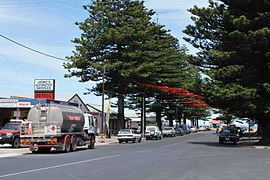Beachport, South Australia
|
Beachport South Australia |
|||||||||||||||
|---|---|---|---|---|---|---|---|---|---|---|---|---|---|---|---|

Main street of Beachport
|
|||||||||||||||
| Coordinates | 37°30′S 140°01′E / 37.500°S 140.017°ECoordinates: 37°30′S 140°01′E / 37.500°S 140.017°E | ||||||||||||||
| Population | 878 (2011 census) | ||||||||||||||
| Established | 1878 | ||||||||||||||
| Location | |||||||||||||||
| LGA(s) | Wattle Range Council | ||||||||||||||
| State electorate(s) | Mackillop | ||||||||||||||
| Federal Division(s) | Barker | ||||||||||||||
|
|||||||||||||||
Beachport is a small coastal town in South Australia, 379 kilometres (235 mi) south-east of Adelaide, located at the northern end of Rivoli Bay, in the Wattle Range Council. Beachport has a large crayfishing fleet, and is known for its 772-metre (2,533 ft)-long jetty, the second-longest in South Australia after the one at Port Germein. The locality of Thornlea is wholly contained within Beachport.
Following the discovery and naming of Rivoli Bay in 1802 by French navigator Nicolas Baudin, a whaling station was established there in the 1830s. The whaling industry soon declined, to be followed in succeeding decades by European pastoralists settling in the hinterland. Whaling was then superseded by a booming wool export industry, leading to the need for a port. The town was named on 23 May 1878 for the then British Secretary of State for the Colonies, Michael Hicks Beach, 1st Earl St Aldwyn.
Beachport is the location of what are believed to be the first casualties of World War II on Australian soil. On 12 July 1941, a local fisherman discovered and towed to Beachport a German sea mine, laid either by the raider Pinguin or the minelayer Passat. The following day, two able seamen, Thomas Todd and William Danswan, part of a three-man Rendering Mines Safe (REMS) team, were killed when a wave lifted the mine and caused it to explode on the beach while they were attempting to defuse it. A monument now stands in the town to honour them.
Beachport was officially proclaimed a port on 21 November 1878. In the same year a lighthouse was erected close by on Penguin Island and a railway from Mount Gambier was completed. A wool and grain store was built in 1879, served by the railway, thereby providing a facility to link the export trade by rail and sea. The railway closed in 1956. The old wool and grain store has been preserved and today serves as a National Trust museum.
...
Wikipedia

